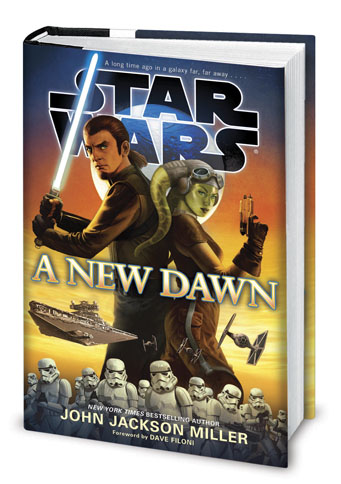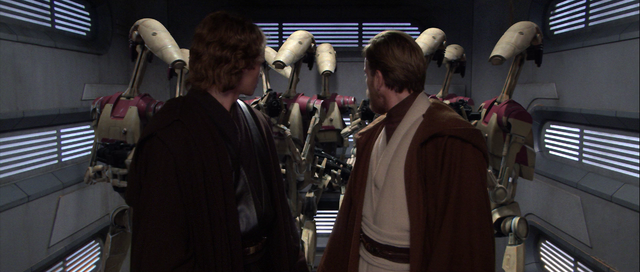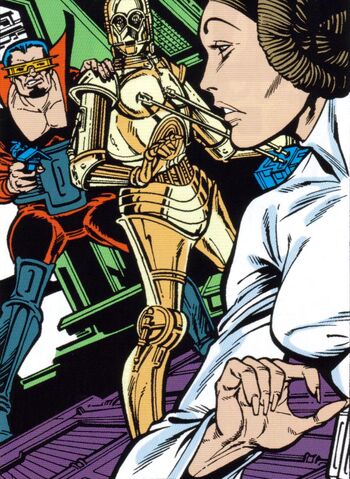 It’s Labor Day here in the states, but Jay Shah had a new interview with John Jackson Miller, author of tomorrow’s new dawn in Star Wars publishing conveniently titled A New Dawn, hot off the presses—and with no regularly-scheduled posts on Tuesdays, I thought it’d be more prudent to let ‘er rip. And don’t miss Jay’s reaction to A New Dawn from a couple weeks ago..
It’s Labor Day here in the states, but Jay Shah had a new interview with John Jackson Miller, author of tomorrow’s new dawn in Star Wars publishing conveniently titled A New Dawn, hot off the presses—and with no regularly-scheduled posts on Tuesdays, I thought it’d be more prudent to let ‘er rip. And don’t miss Jay’s reaction to A New Dawn from a couple weeks ago..
Enjoy! – Mike Cooper, EIC
Eleven-ThirtyEight: How did writing A New Dawn differ from writing the Knights of the Old Republic comics? Aside from the differences in medium between novels and comic books, were there different challenges in writing a story about an upcoming product as opposed to a preëxisting story?
John Jackson Miller: With the KOTOR comics, colliding with new things that were planned in other media wasn’t that much of a problem: KOTOR I and II were already out, and the only real thing I was seeking to avoid was giving away the secret behind the start of the Mandalorian Wars. (I didn’t know what that was being saved for, but it eventually came up in the REVAN novel.) The challenge instead there was making sure that my stories synched up with the backstory developed in the games — and that was often quite daunting, as there was no clearing-house that had the entire script from every possible conversation you could have in the game. There were a couple of times were I had to adapt to lines of dialogue I simply hadn’t seen.
With REBELS, of course, it is a different situation because it’s an ongoing project with more being written for it all the time. But I had access to the story bible and information about the early episodes, and that — plus the feedback from the Lucasfilm Story Group — was really enough. My story is set well before the first episode of REBELS, so it was really more important having access to the executive producers’ thoughts about Hera, Kanan, and what they would think about the Empire in the time my book was set. No, there was no way I could anticipate events that might come up in the series far down the road — but the Story Group knows the events of my book, and so it would theoretically be able to advise later materials. That’s the whole idea, I think.
ETE: Most people who know me are aware that I am a fan of the Empire, but have been rather critical of Imperial sexism as not making much sense in-universe. A New Dawn opens up with a female Imperial Star Destroyer captain who achieved her rank largely on merit, and also features female Imperial officers in a variety of other roles (comms officer, the ship’s lead science officer, and even a majority-female stormtrooper squad). Does this represent a reworking of the old “sexist Imperial” paradigm for the new canon or were you simply being awesome and decided to include competent female Imperial characters because there should be some? Either way, I hope we see more of this in the future, and especially Captain Sloane, who was easily my favorite character in the novel.
JJM: A number of people have commented about the female characters in the story — as well as Sloane’s race — and to be honest, I wasn’t trying to make any kind of statement. I didn’t think twice about including them, in fact — because in-universe, it made perfect sense that in the post-Clone era when recruits are needed to build out the Empire’s ranks, the Emperor would need every talented human he could find.
The Emperor plays on rifts between species and between the populaces of different planets, for sure — and the prejudice against droids in galactic society is well known. But the films don’t suggest significant gender or racial barriers within humanity in general, and I couldn’t see why they would spring up in the Empire. Palpatine happily exploits the talents of all members of his species to get his way. He’s an equal opportunity tyrant.
It wasn’t something I was told to do and I wasn’t seeking to make any kind of imprint on the larger canvas; I’ve just always written diverse casts and was simply continuing that practice. It went through, so take from that what you will.
ETE: This next question comes from my friends at TheForce.net’s Jedi Council Forums, who showed more interest in this aspect of A New Dawn‘s continuity than any other. While I read the SDCC release of the novel, I noticed the use of the terms “elevator” and “restroom” instead of the familiar EU terms “turbolift” and “refresher.” I don’t know if the latter terms ended up appearing elsewhere in the novel, glanced over because they were familiar, but my question is — why were the terrestrial terms used? Was it an attempt to be clearer to new readers, an intentional change for the new canon, or just an accident?
JJM: The Del Rey editorial team and the Story Group look at every word, as you might expect — and while I don’t speak for them on these matters, I believe eliminating “refresher” was intentional, a shift done in the name of being more accessible to new readers. The “refresher” term isn’t used in the movies and has — to my ear, anyway — a gratuitously outer-spacey ring to it that simply isn’t necessary when the room itself serves the same basic purpose. We’re all aware of the trope of using sci-fi names for commonplace concepts and objects; they were used in pulp stories a lot to add flavor for settings, to remind us that we were not on planet Earth. I’m not sure Star Wars stories need a lot of help to seem like a different world!

As for “turbolift”, I don’t know if it was a shift in style: I simply didn’t use that term in the book to begin with, and it went through. My feeling about the term — and it is just my personal view here — is that “turbolift” probably filtered in at some point from Star Trek, because it wasn’t there in the beginning. The term is “elevator” in Alan Dean Foster’s NEW HOPE adaptation, which is likely to be the earliest printed reference. They’re “vacuum elevators” in Marvel’s Episode IV adaptation. Brian Daley called them “lift tubes” in the Episode IV radio play.
Again, I can’t speak for sure about the thinking regarding that one, but I think going for the “terrestrial” term has its merits. Certainly, there are some in-universe things without Earthly equivalents, and we can understand those names being different — just as it makes sense to use “groundquake” for “earthquake.” But alternate names solely for their own sake don’t really add much, beyond confusion for new readers. In Star Trek, turbolifts fuction differently from elevators in several ways, so you can see having a different name for them; but certainly the ones I depicted just are cars that travel up and down, so there was no need to obscure what they were.
Those are just my thoughts; if you want official feedback on stuff like that, it’s a question for the studio.
ETE: In previous interviews, you’ve mentioned that you were given wide latitude for the focus of A New Dawn and that you chose to depict the transformation between Republic and Empire, including how the everyday citizen could be made complicit in a totalitarian régime even through bystanderism. What about the Rebellion? While all indications from Dave Filoni are that the rebels we see in Rebels are not necessarily going to end up affiliated with the Rebel Alliance, they do represent something new and different from previous anti-Imperial resistance movements. Hera in particular has some very interesting ideas on how any revolution must be a concerted, united effort with the overthrow or change of the Empire as its main goal, rather than settling individual grievances. What was your approach with handling resistance to the Empire/overcoming the passivity you highlight in your novel?
JJM: The overarching thought I had was that the Empire would have kept the people placid by walling them off from information about what was going on in the rest of the galaxy. The Emperor was running all these plots within plots within plots; he certainly would have seen that the way to keep the people on the supply worlds from revolting would have been to prevent them from either seeing that things were (a) better someplace else, or (b) seeing that there were others suffering the same fates who might then make common cause with them.
If you’re on Gorse, the planet in NEW DAWN, you see that things are rotten under the Empire — but you also know that life on Gorse wasn’t too good under the Republic, either, so things aren’t that different. And the Empire is feeding propaganda about how life elsewhere in the Empire is great, so what’s the easier thing to imagine? That something dire and horrible has befallen the galaxy — or that you just made a really bad decision about where to live?
The little resistance that would have developed, I figured, would have come from people who had access to the parts of the Holonet the Empire hadn’t yet walled off — so we get Hera talking with various contacts, and Skelly digging around for dirt to suit his conspiracy theories. And then there would have been people in unique positions, like Zaluna, who would have had access to more information. Those would be the people most likely to act first — the folks who have found ways to get past the compartmentalization of information that the Emperor has created.
Hera talks in the book about there needing to be a collective consciousness before action against the Empire can be meaningful, and she’s not just being philosophical there: she’s right. Until you get people thinking galactically, anything happening locally is going to have little effect.
ETE: I would be remiss if I didn’t ask a little bit about Count Vidian. He’s a rather unique villain, especially in that he’s actually a private citizen rather than an Imperial official at all. He’s connected to the Imperial Court — and I particularly enjoyed the re-canonizing of court intrigues among the nobility — but he’s not a governor or general. He’s his own actor, with his own motivations, but he’s surely enabled and empowered by the Imperial system, and even has a Star Destroyer at his beck and call. There are certainly terrestrial analogies that can be made to the military-industrial complex or to the familiar specter of a shady business guru selling quick-tip tapes on television, but what made you choose Vidian as the face of villainy in this first adult novel of the new canon? Is he even the villain at all, or just the face it chooses to wear this evening?
 JJM: Vidian had a precursor in the early comics in Baron Orman Tagge. With Baron Tagge, Archie Goodwin introduced me to the notion that there would be power players in the Empire who would have authority and official leave to act on behalf of the Empire, even though they weren’t part of the government. That put into my head that the Emperor likely would have wanted Republic industrialists and aristocrats on his side, in the early days — and that he would have found it useful if some of those people were still working to make a profit. Tagge was developing weapons against the Rebellion both to make money, and to increase his standing in the Empire, hoping to overtake Vader.
JJM: Vidian had a precursor in the early comics in Baron Orman Tagge. With Baron Tagge, Archie Goodwin introduced me to the notion that there would be power players in the Empire who would have authority and official leave to act on behalf of the Empire, even though they weren’t part of the government. That put into my head that the Emperor likely would have wanted Republic industrialists and aristocrats on his side, in the early days — and that he would have found it useful if some of those people were still working to make a profit. Tagge was developing weapons against the Rebellion both to make money, and to increase his standing in the Empire, hoping to overtake Vader.
That’s precisely the dynamic I looked to include in Count Vidian and Baron Danthe. All these people would have been scrambling for position after the end of the Clone Wars; including Danthe, whose company was one of those caught out on the Separatists’ side. So these people are all tearing at each other trying to impress the Emperor more.
Vidian has that role in common with Tagge, as well as cybernetic vision — but he also differs in a lot of ways. He doesn’t care about family or legacy; his physical condition was so bad that he really does act as though he’s on his second life. It’s easy to see how he would have a callous disregard for life when life nearly abandoned him.
And that made him an interesting foil for the book, I thought. He’s an intelligent and powerful figure, whose goals are consistent with what the Empire would be wanting its minions to do at this point in time. You wouldn’t put a character like this in as the main villain during the Clone Wars era, for example; he’s most suited to be a heavy right now — and so here he is.
That’s it! Folks can find behind the scenes articles on my stories at http://www.farawaypress.com and can follow me on Twitter at @jjmfaraway.
Thanks for taking the time to talk to us! We at ETE greatly enjoy your work, and we hope to see more Star Wars novels penned by you in the future. A New Dawn will be in bookstores tomorrow, and can also be purchased from one of the links on this page.

3 thoughts to “John Jackson Miller on A New Dawn, Elevators, and Being Awesome”
Comments are closed.